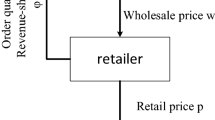Abstract
This study discusses the sustainable development of a fresh agricultural product (FAP) supply chain, which consists of one manufacturer and one retailer, from the perspective of supply chain coordination. The study includes a centralized FAP supply chain, a decentralized FAP supply chain, and a decentralized FAP supply chain under a “revenue-sharing” contract. The study also establishes the profit models of the three FAP supply chains before and after investment in the radio-frequency identification (RFID) technique. Afterwards, the models are compared and the critical values of the cost of the RFID tags are calculated. Finally, the sustainable development of the FAP supply chain is obtained. The revenue-sharing contract facilitates the coordination of the FAP supply chain. In addition, RFID technology application can reduce the loss rate of FAP transportation as well as increase the production cost of FAP and the utilization rate of RFID tag recycling. Furthermore, the RFID technology application itself can be simplified in the future. The more significant these three changes are, the greater the willingness of companies in the FAP supply chain to invest in RFID.




Similar content being viewed by others
References
Apaiah RK, Linnemann AR, Hedzer J (2006) Exergy analysis: a tool to study the sustainability of food supply chains. Food Res Int 39(1):1–11
Blackburn J, Scudder G (2009) Supply chain strategies for perishable products: the case of fresh produce. Prod Oper Manage Soc 18(2):129–137
Cai XQ, Chen J, Xiao YB et al (2010) Optimization and coordination of fresh product supply chains with freshness-keeping effort. Prod Oper Manage 19(3):261–278
Camdereli AZ, Swaminathan JM (2010) Misplaced inventory and radio-frequency identification (RFID) technology. Prod Oper Manage 6(1):1–18
Costa C, Antonucci F, Pallottino F (2013) A review on agri-food supply chain traceability by means of RFID technology. Food Bioprocess Technol 6(2):353–366
Garcia LR, Lunadei L (2011) The role of RFID in agriculture: applications, limitations and challenges. Comput Electron Agric 79(1):42–50
Gaukler GM, Seifert RW, Hausman WM (2007) Item-level RFID in the retail supply chain. Prod Oper Manage 16(1):65–76
Hong IH, Dang JF, Tsai YH et al (2011) An RFID application in the food supply chain: a case study of convenience stores in Taiwan. J Food Eng 106(2):119–126
Heese H (2007) Inventory record inaccuracy, double, marginalization and RFID adoption. Prod Oper Manage 7(16):221–229
Khoshgoftarmanesh AH, Schulin R, Chaney RL (2011) Micronutrient-efficient genotypes for crop yield and nutritional quality in sustainable agriculture. Agron Sustain Dev 30(1):83–107
Lin L, Fan TJ (2014) Research on decision-making of fresh agricultural product supply chain with RFID technology. Syst Eng-Theory Pract 34(4):836–844
Lin L, Yang SP, Dan B (2010) Three-level supply chain coordination of fresh and live agricultural product by revenue-sharing contracts. J Syst Eng 25(4):485–491
Lin L, Yang SP, Dan B (2011) Three-level supply chain coordination of fresh agricultural products with time con-straints. Chin J Manage Sci 19(3):56–63
Lodreejr EJ, Uzochukwu BM (2008) Production planning for a deteriorating item with stochastic demand and consumer choice. Int J Prod Econ 116(2):219–232
Maceae RJ, Henning J, Hill SB (1993) Strategies to overcome barriers to the development of sustainable agriculture in canada: the role of agribusiness. J Agric Environ Ethics 6(1):21–51
Nahmias S (1982) Perishable inventory theory: a review. Oper Res 30(4):680–708
Pathumnakul S, Piewthongngam K, Khamjan S (2009) Integrating a shrimp-growth function, farming skills information, and a supply allocation algorithm to manage the shrimp supply chain. Comput Electron Agric 66(1):93–105
Rekik Y, Jemai Z, Sahin E et al (2007) Improving the performance of retail stores subject to execution errors: coordination versus RFID technology. OR Spectrum 29(4):597–626
Rekik Y, Sahin E, Dallery Y (2009) Inventory inaccuracy in retail stores due to theft: an analysis of the benefits of RFID. Int J Prod Econ 118(1):190–192
Ruiz-Garcia L, Lunadei L (2011) The role of RFID in agriculture: applications, limitations and challenges. J Food Eng 79(1):42–50
Szmerekovsky JG, Zhang J (2008) Coordination and adoption of item-level RFID with vendor managed inventory. Int J Prod Econ 114(1):388–398
Tong B, Yang DL, Pan X (2010) Research on effect of RFID on supply chain lead-time compression and coordination. Oper Res Manage Sci 19(5):52–58
Tong B, Yang DL, Pan X (2010) Retail supply chain enterprise decision-making on RFID adoption. Chin J Manage 7(6):874–878
Wang J, Chen X (2010) Fresh produce wholesaler’s optimal procurement decisions with option contracts. Syst Eng Theory Pract 30(12):2138–2144
Wang J, Chen X (2011) Fresh produce supplier’s pricing decisions research with circulation wastaged and option contracts. Forecasting 30(5):42–47
Wognuma PM, Bremmers H, Trienekens JH (2011) Systems for sustainability and transparency of food supply chains—current status and challenges. Adv Eng Inform 25(1):65–76
Acknowledgments
The authors thank the anonymous referees and guest editors for their valuable and helpful suggestions for the improvement of this paper. This work was supported by the Humanities and Social Sciences Research Planning Fund Project of the Ministry of Education (11YJA630173), the Agriculture Science Technology Achievement Transformation Fund (2013GB2E000353), the Guangdong Province Soft Science Research Project (2013B070206013), the Major Program (71090403/71090400), the Major International (Regional) Joint Research Project (71420107024), and the General Program (71172075) of the National Natural Science Foundation of China.
Author information
Authors and Affiliations
Corresponding author
Rights and permissions
About this article
Cite this article
Yan, B., Shi, S., Ye, B. et al. Sustainable development of the fresh agricultural products supply chain through the application of RFID technology. Inf Technol Manag 16, 67–78 (2015). https://doi.org/10.1007/s10799-014-0196-y
Published:
Issue Date:
DOI: https://doi.org/10.1007/s10799-014-0196-y




